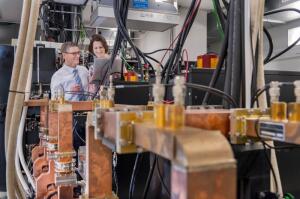by
Lisa Chamoff, Contributing Reporter | March 07, 2017

Prof. Franz Pfeiffer and Dr. Daniela Munzel
at the miniature synchrotron Munich Compact
Light Source (MuCLS).
Using a miniature particle accelerator that produces more precise X-rays, scientists in Germany were able to perform angiography using at least a third of the amount of contrast while still retaining image quality.
While more research is needed before patients can be imaged with this technology, it has the potential to avoid complications from contrast agents in those with kidney problems.
The scientists, from the Department of Diagnostic and Interventional Radiology at the Klinikum rechts der Isar, working with the chair of biomedical physics at the Technical University of Munich (TUM), used monoenergetic X-rays, which were generated by the Munich Compact Light Source (MuCLS). The MuCLS, considered the world's first mini-synchrotron, was introduced at TUM in 2015.



Ad Statistics
Times Displayed: 137680
Times Visited: 7952 MIT labs, experts in Multi-Vendor component level repair of: MRI Coils, RF amplifiers, Gradient Amplifiers Contrast Media Injectors. System repairs, sub-assembly repairs, component level repairs, refurbish/calibrate. info@mitlabsusa.com/+1 (305) 470-8013
Their research was recently published in
Nature Scientific Reports.
“The energy of the X-rays of a compact synchrotron can be adjusted more precisely to an ideal ratio of image quality and dose, compared to a conventional X-ray tube spectrum,” Elena Eggl, chair of biomedical physics at TUM and the paper’s lead author, told HCB News. “A dose reduction appears feasible because low-energy X-rays are spared.”
The scientists researched the MuCLS’s effect on contrast using detailed computer simulations and tests with a pig's heart. They found that the monoenergetic X-rays allowed the required concentration of iodine to be cut by about a third, and an even greater reduction of gadolinium, with no loss of contrast.
“We assumed concentrations of 50 to 75 milligrams contrast agent per milliliter of blood, which lies within the typical clinical range,” Eggl said.
Before the development of the MuCLS, which the researchers say is about the size of a car, the more precise X-rays could only be created with very large circular particle accelerators. Additional work needs to be done before this technology can be used on patients and in a health care setting.
“The most important technical developments would be an extension of the energy range toward higher energies and an increased size of the field of view,” Eggl said.


Sean De La Pena
Congrats to exciting work on Lyncean Compact Light Source
March 10, 2017 04:47
Congratulations to Franz and the team for more exciting results! Lyncean Technologies, Inc. is proud to have provided you with the first delivery worldwide of a Compact Light Source. It is great to see your utilization of some of the unique properties of the Lyncean CLS.
to rate and post a comment